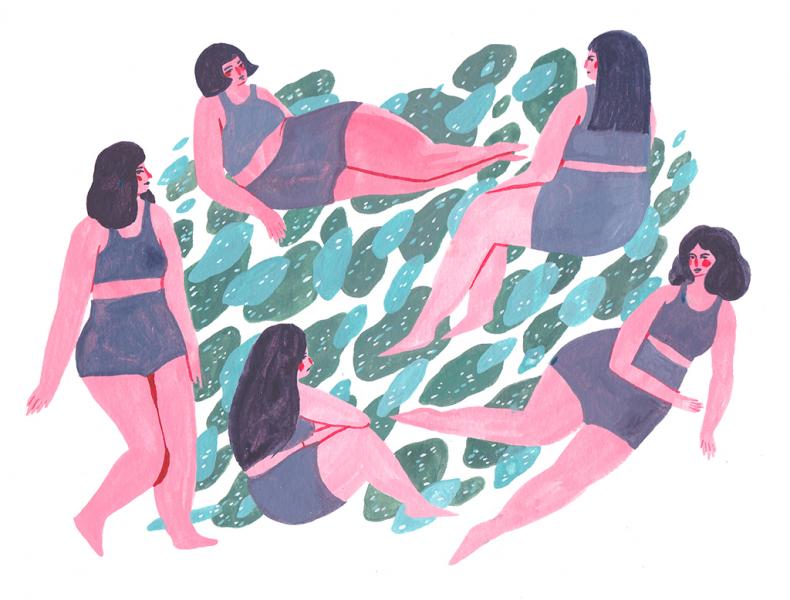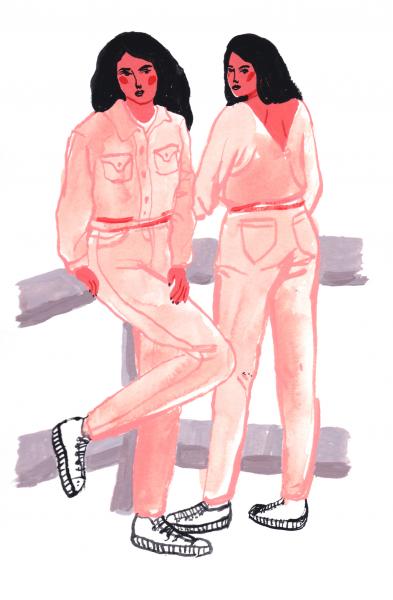Our Annual Cover Art Contest has officially opened again! We took the opportunity and spoke to our first ever winner, Tiffany Mallery, whose winning piece was published recently on the cover our last issue—Room 39.2, Between Shadows. She told us about her life after art school and books that inspire her work. Aside from Room, she has also been published in American Illustration, and Uppercase magazine.
Our Annual Cover Art Contest has officially opened again! We took the opportunity and spoke to our first ever winner, Tiffany Mallery, whose winning piece was published recently on the cover our last issue—Room 39.2, Between Shadows. She told us about her life after art school and books that inspire her work. Aside from Room, she has also been published in American Illustration, and Uppercase magazine.
R: Could you tell me a bit about yourself?
T: My name is Tiffany Mallery and I’m a recent graduate from Lesley University’s College of Art and Design where I received my BFA in Illustration. I currently reside in the United States Midwest where I have an unrelated-to-art full-time job. The rest of my time is spent making art and hanging out with my dog! Some things I really enjoy are antique stores, traveling, thunderstorms, and new paintbrushes.
R: Please tell me about “Blood Moon”.
T: The painting was inspired by the Super Blood Moon that occurred last September—I think I painted it a couple days after. When I’m doing an unplanned piece I tend to default to the same subjects, like a girl gazing out in the distance or looking off to the side. I think it’s because I’m a girl who spends a lot of time inside her own mind or spacing out. At the end of the day I think “Blood Moon”, like much of my personal work, is autobiographical at its core but the narrative is vague enough for the viewer to not feel like they’re witnessing someone preening in front of the mirror. The girl in the painting is me, for sure, but it’s also you, your friend, the stranger sitting next to you on the bus. I think everyone’s looking up at the moon, especially a moon that is so special it gets articles written after it, and I think everyone feels small and grounded—in a good way—when they do. It’s a hard and specific mood to capture, but I’m pretty satisfied with the outcome!
R: When did you start drawing and painting?
T: I’ve been making art since as far back as I can remember. My dad’s office was covered floor to ceiling in drawings my sister and I made for him. It was a pretty serious hobby. I didn’t really consider becoming an illustrator until the start of high school, and even then it’s been a really slow journey coming into my own as an artist. I just try to stay passionate about it. Even though it’s something I want to do full-time, I don’t think I ever will consider it a job because it feels so much like playing. Even the stress it causes me sometimes is enjoyable! It keeps me on my toes.
R: Do you draw everyday? How do you get motivated and inspired on a regular basis?
T: I try really, really hard to draw everyday, even if it’s a stupid doodle. If I can’t find it in me to draw, I at least try to be creative and make something in some manner—so I’ll knit or bake or cook a more complex meal than I usually do. I graduated college about a year ago and one of the most stressful moments during that time was when I realized I would no longer have the structure and constant flow of projects coming at me. Even though college was exhausting and I was glad to be out, it was a little scary not knowing if I would be able to self-start and keep motivated to make work. A lot of what helps me now is being on Instagram and using that as a tool to keep tabs on how frequently I’m making stuff, even if it’s sketchbook work or whatever. I get distracted really easily and making a point to update it everyday or at least try to has helped a lot in creating and keeping up with this personal practice.
R: Are there any books that have really helped you with your art?
T: The list is endless, honestly! The top contenders have been Taschen’s Illustration Now 2, which was pretty much what set me on the path to illustration. I read it when I was a high school freshman and didn’t even realize illustration was a field I could go into. I also really love the hand-lettering book Handjob, which I also read through in high school and throughout college. Other books have been the American Illustration annuals, which I’d idly flip through in college, graphic novels like Into the Woods by Emily Carroll, Wonton Soup by James Stokoe, pretty much the entirety of Bryan Lee O’Malley’s work, and This One Summer by Jillian and Mariko Tamaki. I’ve only ever dipped my feet into comic-making, but a lot of the work I make is narrative-based, even though the majority of that narrative stays internal as I draw, so much of my book-derived inspiration comes from graphic novels and comics.
R: Whose work do you admire?
T: There are so many artists I admire and who provide constant inspiration! Yuko Shimizu and Marcos Chin’s work ethics and portfolios are incredible. They provide such great insight into their process on their social media accounts and they make it very clear that illustration is a job you go into everyday, just like any other, and requires dedication, effort and oftentimes a lot of overtime. I also really love Kaye Blegvad, Carson Ellis, Jillian Tamaki, Monica Ramos, and Bryan Lee O’Malley. Their styles and the content they put out have been such huge inspirations for me, especially in the past couple years when I’ve really started to find my own visual voice.
R: Do you participate in art contest or submit your work often? What has been your experience of it so far?
T: I’m trying to submit to the bigger publications and annuals at least once a year like American Illustration, Creative Quarterly, 3×3, Society of Illustrators, and Communication Arts. My senior year of undergrad I was really lucky to get published in the American Illustration annual, which was a really good confidence boost for me. It’s easy to get stuck in a mental circle; to feel like you’re not ready to submit to the big competitions and once that’s in your head, it kind of stays. I think most of it just depends on who is curating or jurying that particular issue or competition, and how your work stands out from the other submissions, so keeping that in mind, it makes me feel a bit better about submitting work as someone just starting out!
R: How else do you get your work out there?
T: Social media is a great way to get your work out there, but also opening yourself to creating and keeping up with great contacts—especially if you don’t have the resources or free time to travel to conventions—tables at markets, and attending gallery openings or popup shops regularly. It’s also a great way to find your niche audience and likewise broaden your reach. It feels like I’m using a lot of business-y buzzwords to describe the whole thing, but basically: be active on social media! Find one you like, keep that as your main one, and branch out from there when you get more comfortable, or have built your audience.
R: You dabble in both personal and commissioned work; what advice do you have for emerging artists looking to get paid for their craft?
T: My advice is to just make work! Everyone’s circumstances are different but we all start out the same way: if you’re just getting out of college, you’ll find you no longer have regular projects you’re working on or grades or critiques to look forward to. Alternatively, you might be moving to a new city or venturing into art as a career change and lack connections, community, structure, etc. Don’t get discouraged if you don’t have clients right off the bat or commissions coming in regularly. Be your own client; commission yourself; toss your work out into the internet void and most importantly—email and send mailers to people you want to work with! It’s difficult, and there’s no right way to do it, but these are things I’ve learned have helped me stay on task. Also something I am still learning is how to put value on my work. For so long art-making has been a hobby, and not a service I’m selling, so getting into that mindset has been no picnic. But it sets a tone and a level of professionalism when you interact with potential clients, and that’s kind of a big deal if you want to get paid. A really helpful guide for this is the Graphic Artist’s Guild Handbook of Pricing and Ethical Guidelines. The title’s a mouthful but it has a lot of great advice for graphic artists, designers, and illustrators who want to get paid (and fairly)!
Below are two of Tiffany Mallery’s pieces, Summer Bummin’ and Untitled.
















